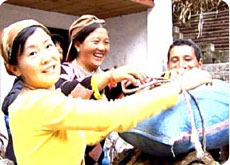An ultimate test of character, the journey became trade as much as pilgrimage, material profit as much as spiritual merit.
My fellow travelers have been out on the road for days even months, crossed the world's most inhospitable terrain; but they carry the brightest grins on their faces, and the most uninhibited singing.

Qiu Na Tong is the last stop inside Yunnan Province before caravans enter Tibet. The villagers are mostly Nu, Lisu and Tibetain. Most Nu people in the village can speak Tibetan, as the place used to be dominated by Tibetans half century ago.
Nu nationality is only to be found in Nujiang Prefecture, and is the only indigenous people in Nujiang valley.
Many Nu customs are related to slab stones, such as what our host family is doing here, making "slab pancake".
Easy to operate, clean and tasty, no wonder "slabstone pancake" has become a major gourmet food for Nu people to treat guests.
The dinner consists of only two dishes, fresh homegrown vegetable and free-range chicken. Yet, it might be the biggest feast caravans have eaten on this trip.
Like other minorities, Nu people are also good at and fond of singing and dancing.
It's hard to say when is the best time to visit Bing Zhongluo as every season here bears a distinguished view. A safe bet is around September and October when the rice paddy fields turn gold.
My first destination at Bing Zhongluo is Puhua temple at dongfeng village. Originally a Han-style Buddhist temple, Nowadays, it's the most famous lama temple in Bing Zhongluo.
Because of language barrier, Xiaolan was not able to figure out why the sculpture of a Taoist god is in the temple. But it may not appear so out-of-place in this small village where you can find believers of Tibetan Buddhism, Chinese Buddhism and Catholicism.

